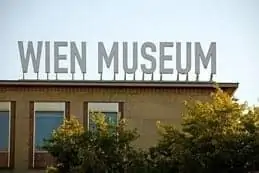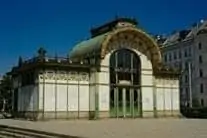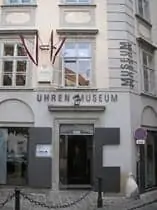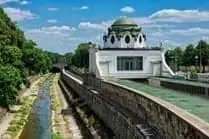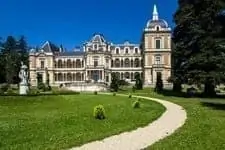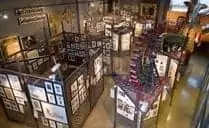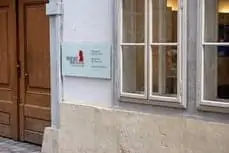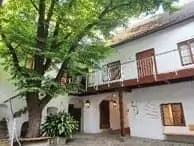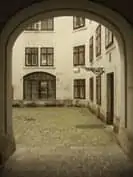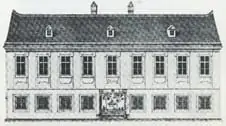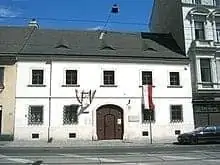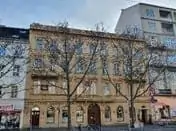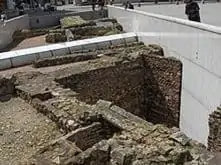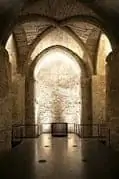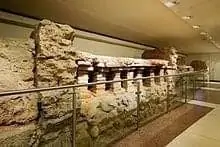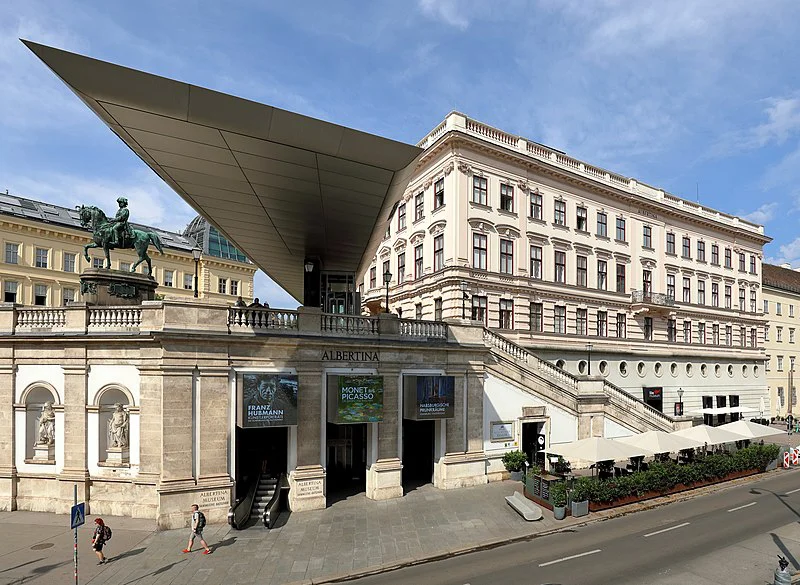Where is the Wien Museum located? What can you visit there? Which other museums are managed by the Wien-Museum? What is the mission of the museum? When is the reopening scheduled after the renovation phase?
In April 1959 the time had come: the Vienna Museum was opened on Karlsplatz , as the first new museum building of the Second Republic. Oswald Haerdtl was the architect of the modern building and also designed the interior.
Where were the collections on the history of Vienna housed before? The Historical Museum of the City of Vienna had existed in the Vienna City Hall since 1887 . Since the beginning of the 20th century, plans were already underway. its own museum. Otto Wagner already had plans in mind, but two world wars were to intervene.
In 2002, the roofing of the inner courtyard was carried out. The museum provides a comprehensive overview of the urban development of Vienna from the Neolithic period through the Roman era to the 21st century. A focus is also dedicated to the work of Gustav Klimt .
Currently closed for redesign, it is expected to reopen in the fall of 2023 . The exhibition area is then to be doubled (approx. 12,000m²). A terrace with a café and a beautiful view of the Karlskirche is to be added.
What other museums are part of the Wien Museum? More info: VIENNA MUSEUM
– Otto Wagner Pavilion Karlsplatz
In the former station building, you can learn about the life and works of Otto Wagner. Here you can also see how many works Otto Wagner could not realize due to the conservative taste of Emperor Franz Joseph. Exactly opposite is an identical pavilion, which houses a café as well as a staircase to the U1/U2/U4 Karlsplatz. Under Karlslatz is the largest traffic junction in Vienna.
– The watch museum
The Palais Obizzi in the center of Vienna is home to the Watch Museum. 1917 founded, the collection goes back to the director Rudolf Kaftan and the poet Marie von Ebner-Eschenbach . It was also called the House of Ten Thousand Clocks and it is a specialty in all of Europe, especially for watch fans.
– Otto Wagner Hopavillon Hietzing
Also clearly attributable to Otto Wagner is the pavilion that served the emperor as an embarkation and disembarkation point and is located along the U4 line between Schönbrunn and Hietzing. It was opened in 1898, but hardly ever used by Emperor Franz Joseph , although Wagner even included neo-Baroque elements in its construction for the Emperor’s sake.The Hietzing light rail station used to be located on this site, but was later demolished. Nowadays exhibitions are held in the pavilion.
– Vienna Museum Hermesvilla
Emperor Franz Joseph had a fairy-tale castle built for his beloved Elisabeth (Sisi) in the middle of the
Lainzer Tiergarten to keep them more in Vienna, which unfortunately did not work. The architect was Karl Freiherr von Hasenauer, who constructed the building from 1882-86. The permanent exhibition reports that Sisi stayed in the Hermes Villa only a few days a year.
– Prater Museum
© CCO
The Prater Museum can be found in the Prater , between the Ferris wheel and the main avenue, right next to the planetarium . Old curious objects can be visited. It gives insight into the history of Wurstelprater, the largest amusement park in Vienna.
The following musician apartments can be visited:
– Mozart House Vienna
Mozart lived at Domgasse 5 right next to St. Stephen’s Cathedral from 1784-87 . It is his only surviving apartment of the approximately 16 residential addresses he had in Vienna. Unfortunately, there is nothing left of the original furniture . Mozart composed in this house “Figaro’s Wedding”, therefore the house was also called Figaro House . He is also said to have composed the “Magic Flute” in this apartment.
– Beethoven apartment Heiligenstadt
Ludwig van Beethoven spent the summer of 1802 at Probusgasse 6 in Heiligenstadt . Heiligenstadt had a spa and baths and at that time had healing springs . Beethoven sought to cure his incipient hearing ailment here. The famous
“Heiligenstadt Testament” he wrote here, which was nothing more than a desperate letter to his brothers, where he expressed his concern about the state of his hearing.
– Beethoven Pasqualati House
© CC BY SA 3.0 en
Johann Baptist Freiherr von Pasqualati was a patron of Beethoven and the house on the Mölker Bastei belonged to him. He rented it to Beethoven from 1804-1808 and from 1810-1814. The latter loved the view of the Vienna Woods from the highest floor. He wrote there, among others, “Für Elise” , and his only opera “Fidelio” . Since the actual apartment is rented out, the neighboring apartment is simply shown as a Beethoven memorial.
– Haydn House
Joseph Haydn lived in this house at what is now Haydngasse 19 in Mariahilf from 1793 until his death in 1809 . He composed the “Creation” and the “Seasons” here. A separate room is dedicated to Johannes Brahms , who was an ardent admirer of Haydn .
– Schubert birthplace
Franz Schubert was born at Nußdorferstraße 54 (9th district) on January 31, 1797 , the thirteenth child of nearly 20 children. He spent the first four and a half years of his life here. The most important object of visit is the famous glasses, which Schubert allegedly did not take off even at night, as he always wanted to be prepared to compose. About 50 paintings by the famous poet Adalbert Stifter, who also painted, are exhibited here.
– Schubert star apartment
At Kettenbrückengasse 6, near the Naschmarkt, where Schubert died at the age of only 31 from syphilis or as a result of typhoid fever, he spent only 2.5 months at his
Brother Ferdinand.
I came into the world for nothing but composing,”
Schubert is said to have said about himself to a friend.
– Johann Strauss apartment
In the Praterstrasse 54 lived in the 2nd district Johann Strauss son (1825-1899) in the 1860s and in this house he composed the world-famous Danube Waltz. He was considered the waltz king of Vienna, but he was also a Composer of operettas (Die Fledermaus). A special exhibit is the precious Amati violin, which is said to have been in his possession.
Excavation sites are also part of the Wien Museum, such as the archaeological excavations at Michaelerplatz.
In 1989-91, under the direction of Hans Hollein , the excavations were made at Michaelerplatz, directly in front of the main entrance to the Hofburg. Remains from the Roman camp suburb of Canabae came to light. These can be visited at any time and free of charge and are located in the middle of the city.
– Virgil Chapel
© CC BY SA 4.0
To this day, the Virgil Chapel near the U1 St. Stephen’s Cathedral station in the middle of the city remains a mystery. It is said to have been built around 1250 and to have served as a crypt for a rich Viennese family from the 14th century . Above it was the Magdalene Chapel, which was rebuilt at the end of the 18th century. burned down. As a result, the underground Virgil Chapel was filled in and fell into oblivion. In the course of the construction of the subway in 1973 it was discovered and can be visited today, together with the Museum of the Middle Ages . Here you can learn how big Vienna was at the time of the Middle Ages, who was mayor and what was going on in the city.
– Roman museum
© CC BY SA 4.0
At the Hoher Markt, in one of the oldest squares in Vienna, is the underground Roman Museum . In this area were located the officers and tribunes. Ceramics, gravestones and other objects testify to the former Roman camp Vindobona.
– Neidhart frescoes
If you are interested in medieval wall painting , the Neidhart Festival Hall at Tuchlauben 19 is a good place to go. Anf. of the 15th c. the ballroom of the Viennese cloth merchant Michel Menschein was equipped with it. They are considered the oldest preserved secular wall paintings in Vienna. A picture cycle depicting scenes from the life of the minnesinger Neidhart von Reuental . They were discovered in 1979 in the course of reconstruction work and offer an everyday insight into medieval life in Vienna.
Time Travel Tip: Every 1st Sunday of the month, all museums listed here that are part of the Wien-Museum offer free admission!

